
About UsThe Numismatic Bibliomania Society is a non-profit organization promoting numismatic literature. For more information please see our web site at coinbooks.org SubscriptionsThose wishing to become new E-Sylum subscribers (or wishing to Unsubscribe) can go to the following web page link MembershipThere is a membership application available on the web site Membership Application To join, print the application and return it with your check to the address printed on the application. Membership is only $15 to addresses in the U.S., $20 for First Class mail, and $25 elsewhere. For those without web access, write to: David M. Sundman, Secretary/TreasurerNumismatic Bibliomania
Society AsylumFor Asylum mailing address changes and other membership questions, contact David at this email address: dsundman@LittletonCoin.com SubmissionsTo submit items for publication in The E-Sylum, just Reply to this message, or write to the Editor at this address: whomren@coinlibrary.com
BUY THE BOOK BEFORE THE COINYou won't regret it! |
- WAYNE'S WORDS: THE E-SYLUM JUNE 21, 2009
- GEORGE FREDERICK KOLBE AUCTION SALE 110 RESULTS
- NEW SECTIONS AND UPGRADED PHOTOS FEATURED IN 2010 RED BOOK
- BOOK REVIEW: COLLECTING GUIDE TO THE PIONEER COINAGE OF AMERICAN SALOONS
- NUMISMASTER ARCHIVE REACHES 3,000 ARTICLE MARK
- THE ONE HUNDRED GREATEST ITEMS OF U.S. NUMISMATIC LITERATURE
- HARVEY G. STACK ANNOUNCES HIS RETIREMENT FROM STACK’S
- NEW BLOG: BRITISH ARMY MEDALS
- MORE ON CUTTING UP NUMISMATIC LITERATURE
- NOTES ON COIN DENOMINATIONS
- MORE ON DIGITIZING NUMISMATIC LITERATURE
- SCRIBD: AN ALTERNATIVE TO THE AMAZON KINDLE
- VOCABULARY WORD: REFUTE
- 1786 CONNECTICUT COPPER FOUND IN NORTH CAROLINA
- INTERVIEW WITH ART OF COUNTERFEITING AUTHOR
- QUIZ ANSWER: JAMES D. FOSKETT, FIRST ANS LIBRARIAN
- QUERY: WERE STEUBEN SOCIETY MEDALS DESIGNED BY ALPHONSE KOLB?
- FIRST NEW YORK NUMISMATIC CLUB MEETING PHOTO
- BASEBALL CURRENCY ADVERTISING NOTES
- MORGAN, BUFFETT AND THE PANIC OF 1907
- SAMUEL JOHNSON REMEMBERED WITH COIN COLLECTION GAME
- PUB COINS INSCRIBED BY WWII SOLDIERS
- FLEA MARKET BOOK PURCHASE INCLUDED A NATIONAL BANK NOTE
- ANOTHER GREAT FLEA MARKET FIND: THE FEDERALIST PAPERS
- STOLEN ICE HOUSE COVER STAMP RESURFACES
- GERMAN VENDING MACHINES TO DISPENSE GOLD
- LARGEST COUNTERFEIT CRIME IN HISTORY?
- FUN WITH 250 LIBRARIANS
- FEATURED WEB PAGE: MARK WAGNER’S CURRENCY COLLAGES
WAYNE'S WORDS: THE E-SYLUM JUNE 21, 2009
 We now have 1,232 subscribers - no one new this week.
We now have 1,232 subscribers - no one new this week. This week we open with some results of George Kolbe's latest sale, new information in the 2010 Redbook, and a review of Fred Holabird's new saloon token book.
Next we discuss NumisMaster.com, the 100 Greatest Items of Numismatic Literature survey results, and in the here-comes-the-other-shoe department, we have more news about Stack's.
Other topics include British Army Medals, coin denominations, baseball currency, a Nebraska 1907 Clearinghouse note, and some great flea market finds. To learn about what could be the largest counterfeiting scheme in history, read on. Have a great week, everyone!
Wayne Homren
Numismatic Bibliomania Society
GEORGE FREDERICK KOLBE AUCTION SALE 110 RESULTS
- The virtually unobtainable first two issues of Q. David Bowers Rare Coin Review, issued under the Hathaway and Bowers Galleries banner, were estimated at $750 and, after spirited bidding, each brought $3,450 [prices cited include the 15% buyer premium];
- the very rare original Frankenhuis catalogue of World War I medals was hotly contested for, selling for $1,265 on a $350 estimate;
- the first work on Civil War Tokens, published in 1863, sold well at $1,897;
- an extremely rare and extensive illustrated guide to counterfeit and genuine world banknotes issued in the 1980s and 1990s by the National Bank of Yugoslavia brought $948;
- a 1880s William von Bergen publication featuring contemporary information on the Adolph Weyl 1804 Dollar sold by the Chapman brothers, the first we have ever encountered and estimated at $100, ended up realizing $1,437;
- Charles Chaplin’s delightful 1865 "Gointoem Strong" spoof on American coin sales of the day sold reasonably at $488 on a $500 estimate;
- a complete set of Sylloge of Coins of the British Isles Volumes 1-59, 1958-2007, sold for $2,415;
- the first 192 Stack’s auction sale catalogues, 1935-1964, lacking only three sales, brought an impressive $5,060;
- a fine original edition of Hickcox’s 1858 Historical Account of American Coinage, the first substantial work on the topic was estimated at $850 and brought $1,840;
- fine examples of the original, superbly illustrated, 1887 and 1896 classic Rollin & Feuardent catalogues of the Ponton d’Amécourt and H. Montagu collections of Roman gold coins each sold for $862;
- a fine set of the five volume Mazzini work on Ancient Roman coins, from the library of the celebrated numismatist Dr. Pierre Bastien, brought $2,587.
Copies of the catalogue may still be obtained by sending $15.00 to George Frederick Kolbe, P. O. Drawer 3100, Crestline, CA 92325.
NEW SECTIONS AND UPGRADED PHOTOS FEATURED IN 2010 RED BOOK
Dennis adds:
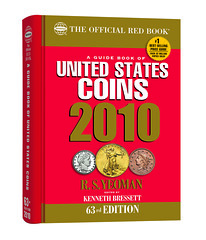 The 2010 (63rd) edition of the Guide Book of United States Coins (known to collectors as the “Red Book”) includes many new features, plus dozens of additions to the book’s 1,800-plus color photographs.
The 2010 (63rd) edition of the Guide Book of United States Coins (known to collectors as the “Red Book”) includes many new features, plus dozens of additions to the book’s 1,800-plus color photographs.“One of the most exciting sections is a new appendix on Significant U.S. Mint Errors,” said Whitman publisher Dennis Tucker. Its text and photographs were contributed by specialists Nicholas P. Brown, David J. Camire, and Fred Weinberg. The new appendix gives a history of mint errors, and illustrates rare and valuable misstrikes and errors including a 1943 steel cent struck over a Mercury dime; an 1863 capped-die Indian Head cent; a 1906 Indian Head cent struck on a $2.50 gold planchet; a 1904 Lewis and Clark gold dollar with a reverse brockage; a Peace dollar struck on a blank quarter planchet; a Bicentennial quarter double strike; a Lincoln cent struck off-center on a Roosevelt dime; the famous bronze 1943 cent; a 2000 Sacagawea dollar muled to a Washington quarter; and other rare oddities worth $2,500 to $150,000 or more.
In the book’s introduction, the “Coins From Treasures and Hoards” section includes a new essay on the SS New York, a passenger ship lost in September 1846 and recovered in 2007 along with thousands of gold and silver coins.
In the “Pre-Federal Issues” section, readers will find dozens of upgraded photographs of colonial and early American coins and tokens, as well as newly added variety photos. “The results are impressive,” said the book’s longtime editor, Kenneth Bressett. “Compare a 2009 edition to the new 2010 edition; it’s like seeing our colonial history with new eyes.”
More closeup photographs of varieties have also been added to the federal coinage sections, including half cents, Indian Head cents, Lincoln cents, and Buffalo nickels. In the back, more Civil War tokens are pictured.
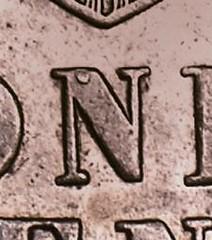 “The 1875, Dot Reverse, Indian Head cent is an interesting addition,” said research editor Q. David Bowers. “It’s believed to have been struck to help catch a Mint employee suspected of stealing coins.” Enlargements of Variety 1 and Variety 2 of the 1886 Indian Head cent are among several other varieties pictured for the first time.
“The 1875, Dot Reverse, Indian Head cent is an interesting addition,” said research editor Q. David Bowers. “It’s believed to have been struck to help catch a Mint employee suspected of stealing coins.” Enlargements of Variety 1 and Variety 2 of the 1886 Indian Head cent are among several other varieties pictured for the first time.New content has been added to cover the 2009 Lincoln cent designs, the Native American “Three Sisters” dollar, the DC/Territorial quarters, and the upcoming 2010 National Parks quarters. In the Bullion section, new information has been added about the “burnished” Uncirculated coinage, as well as the expanded American Buffalo gold program and the 2009 Ultra High Relief gold coin. The year’s new commemorative coins and sets are also studied.
Throughout the 2010 edition, record-setting auction results have been updated for significant coins, with many 2008 and 2009 records listed among early copper, silver, and gold.
In addition to the 2010 Red Book’s nearly 40,000 individual coin prices in up to nine grades per series, Appendix E showcases the Top 250 Auction Prices for U.S. coins. “We’ve tracked auctions through early 2009,” said valuations editor Jeff Garrett, who noted an increase of $35,000 compared to the 2009 edition’s list. “Last year’s 250-ranked coin sold for $310,000,” Garrett said. “To make it onto this year’s list, the 250-ranked coin (a 1776 Continental dollar) sold for $345,000.”
Appendix C, “Collectible Red and Blue Books,” has been expanded with more details, including how to precisely identify the Blue Book’s early editions of the 1940s and 1950s. Coverage of recent collectible Red Books includes the leather-bound Limited Editions, the 2009 Journal Edition, and the rare 2008 Numismatic Literary Guild variety (valued at $800, with only 135 made).
The Red Book’s numismatic bibliography continues to be updated with current literature. Its 125 listings include more than a dozen references published in 2008 and 2009.
BOOK REVIEW: COLLECTING GUIDE TO THE PIONEER COINAGE OF AMERICAN SALOONS
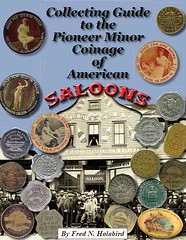 Collecting Guide to the Pioneer Coinage of American Saloons, 2008, Editor - Fred N. Holabird
Collecting Guide to the Pioneer Coinage of American Saloons, 2008, Editor - Fred N. Holabird Reviewed by: John and Nancy Wilson, NLG
A Collecting Guide to the Pioneer Minor Coinage of American Saloons by Fred N. Holabird is a 144 page soft cover reference with all illustrations in color which was released in 2009. Fred stated the idea for this reference came from his two decades of Holabird Americana Pioneer Minor Coinage Auctions to which he added dozens of city directories from all over the country as sources of information. We have several of these Holabird Sale Catalogs in our library.
The guide explains what a saloon is and the use of these tokens and the history of saloons. Fred says, "Saloon tokens are some of the most sought-after tokens or coins by collectors today." The book covers The Western Saloon, The Western Mining Camp Whisky and Saloon Business, The Western Saloon Illustrated, Tokens as Money, Pioneer Minor Coinage.; Saloons as a Percentage of American Business, Saloon Tokens, The Brunswick-Balke-Collender Co, What is a Saloon Token, The End of the Saloon, Saloon Names and Saloon “Good-for Pocket Mirrors.
Saloon coins (tokens) from every state in the union are shown by state with the number of towns with saloon tokens along with the total of saloon tokens known. As an example, CA is listed as having 363 towns having issued saloon tokens with 1558 examples in the census. Three states, New Hampshire, South Carolina and Vermont are listed as having no towns known for issuing these tokens and of course none in the census. The information on each state gives many interesting facts about the saloons and what problems they encountered in operation. Many states and towns outlawed the sale of alcohol and this provided some novel ways the saloon owners handled this law.
Fred says it all in this statement regarding his reference:
A copy of a Collecting Guide to the Pioneer Coinage of American Saloons, by Fred Holabird lists for $24.95 and you have several options for purchasing it. You can call (775) 852-8822 or email Fred at: info@holabirdamericana.com You may also write: Holabird-Kagin Americana, A division of Kagin’s, Incorporated, 3555 Airway Drive Suite #308, Reno, NV 89511.
The link to the page with the books for sale at Holabird / Kagin is: www.holabirdamericana.com/HKA_2008_Cat2/HKA_2008_Cat2_Frameset.htm
NUMISMASTER ARCHIVE REACHES 3,000 ARTICLE MARK
"Everything you need to know about coins and coin news, you can find on NumisMaster," said online editor Lisa Bellavin. "It's the perfect site for anyone interested in numismatics."
NumisMaster users will find useful information and the latest news stories on U.S. and world coins, bank notes, medals and exonumia. Stories for the Web site generally come from magazines published by Krause Publications, such as Bank Note Reporter, Numismatic News, World Coin News and Coins.
Many of the articles seen on NumisMaster are written by numismatic authorities David Ganz, Kerry Rodgers, Richard Giedroyc, Patrick Heller, Allen Mincho, Fred Reed and R.W. Julian. KP numismatic experts David Harper, Tom Michael and George Cuhaj maintain blogs on the site.
To visit NumisMaster, see: www.numismaster.com
Bit by bit more and more great numismatic information is becoming available on the web. When I started what is now The E-Sylum over ten years ago, I held a vision of what the online world would be like someday - electronic newsletters like mine from all the major clubs, online versions of numismatic periodicals, and digitized copies of a great deal of numismatic literature. That future has now come to pass. Even COIN World is available by electronic subscription.
We still have a long way to go to that Numismatic Infomaniac Nirvana where everything ever published on numismatics is both available and easily accessible, but step by step we're getting there. The E-Sylum archive alone has over 10,000 articles.
So what will the NEXT ten years will bring? Send us your thoughts. -Editor
THE ONE HUNDRED GREATEST ITEMS OF U.S. NUMISMATIC LITERATURE
The latest issue of our print journal, The E-Sylum features the final installment of The One Hundred Greatest Items of United States Numismatic Literature: A Survey of the Numismatic Bibliomania SocietyThe survey was organized and tabulated by Len Augsburger, who also wrote excellent descriptions of each of the 100 works. The result is an incredibly interesting and useful article. Together with Dick Johnson's companion article discussing the survey and offering suggestions and alternatives, the issue (and the one before it with the first part of the survey) are easily among the best of the journal's 25+ year run.
The survey and its outcome will likely be a topic of discussion for some time. One thing the survey disproved however, is the stereotype of NBS members as being interested only in dusty old classic books - a good number of the selected works were published only in the last twenty years or so, including the top vote-getter, which may be a surprise to many.
Here are some excerpts from the article for the top two vote-getters.
 Revered and reviled, Breen’s magnum opus remains the first reference of choice for American numismatists. Although justifiably maligned for technical faults and lack of supporting documentation, Breen’s breadth is staggering. Nowhere else is so much information packed into a single volume. Pre-federal, federal, territorial, commemorative, it is all here. Allowed only one book in an American numismatic library, this would be the expected choice. With copies on the secondary market selling for hundreds of dollars and no competitors in sight, this reference will endure as the standard comprehensive guide for the foreseeable future.
Revered and reviled, Breen’s magnum opus remains the first reference of choice for American numismatists. Although justifiably maligned for technical faults and lack of supporting documentation, Breen’s breadth is staggering. Nowhere else is so much information packed into a single volume. Pre-federal, federal, territorial, commemorative, it is all here. Allowed only one book in an American numismatic library, this would be the expected choice. With copies on the secondary market selling for hundreds of dollars and no competitors in sight, this reference will endure as the standard comprehensive guide for the foreseeable future. 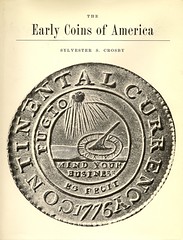 If Breen is one bookend of American numismatics, Crosby is surely the other. In 1875, Crosby had not even the use of a telephone to aid his research. On the other hand, he had access to the great collectors and collections of yore, among them Bushnell, Stickney, Parmelee, Appleton, Maris and others, all giants on the 19th century American numismatic scene. Crosby’s dive into the primary source documentation surrounding colonial issues is beyond remarkable, particularly in light of the lack of modern bibliographic resources. Coupled with his observant technical eye and capable cataloguing, this work is properly described by Davis as “the masterpiece of nineteenth century numismatic literature.”
If Breen is one bookend of American numismatics, Crosby is surely the other. In 1875, Crosby had not even the use of a telephone to aid his research. On the other hand, he had access to the great collectors and collections of yore, among them Bushnell, Stickney, Parmelee, Appleton, Maris and others, all giants on the 19th century American numismatic scene. Crosby’s dive into the primary source documentation surrounding colonial issues is beyond remarkable, particularly in light of the lack of modern bibliographic resources. Coupled with his observant technical eye and capable cataloguing, this work is properly described by Davis as “the masterpiece of nineteenth century numismatic literature.” Among the recent works named to the Top 100 is one of my favorites, and I'm glad to see it placed highly in the ranking.
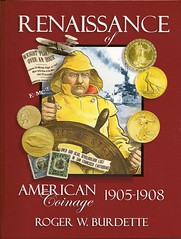 Burdette’s three volume masterpiece, exploring coinage designs introduced between 1905 and 1921, is instantly the standard reference on the subject. Here is the definitive word on experimental St. Gaudens’ pieces, proof Peace dollars, and the exposed breast on the Standing Liberty 1916 quarter, to name only a few. Meticulously researched from archival records and thoroughly documented, Burdette’s legacy may actually exceed the work itself if even a few new writers aspire to his methodology. Burdette utilizes to great advantage both traditional and electronic resources and is completely transparent in his presentation. The present writer recently uncovered what was surely new and interesting information, only to find the subject already well treated in Burdette – an experience we expect to occur repeatedly in the future.
Burdette’s three volume masterpiece, exploring coinage designs introduced between 1905 and 1921, is instantly the standard reference on the subject. Here is the definitive word on experimental St. Gaudens’ pieces, proof Peace dollars, and the exposed breast on the Standing Liberty 1916 quarter, to name only a few. Meticulously researched from archival records and thoroughly documented, Burdette’s legacy may actually exceed the work itself if even a few new writers aspire to his methodology. Burdette utilizes to great advantage both traditional and electronic resources and is completely transparent in his presentation. The present writer recently uncovered what was surely new and interesting information, only to find the subject already well treated in Burdette – an experience we expect to occur repeatedly in the future. Congratulations to Len and the Numismatic Bibliomania Society for producing the survey and "stirring the pot" on the topic of the best numismatic literature. New literature is added to the canon every month, and future updates to the survey will provide a window into the evolving nature of U.S. numismatic literature.
THE BOOK BAZARRE
HARVEY G. STACK ANNOUNCES HIS RETIREMENT FROM STACK’S
Harvey celebrated his 81st birthday on June 3, 2009 in the same month as his 62nd anniversary as a full time member of Stack’s. Prior to his full time status, Harvey did many years of apprentice work, helping his family in their offices whenever it didn’t interfere with a holiday or his schooling.
Harvey was the son of Morton M. Stack and nephew of Joseph B Stack, the early pioneers of Stack’s when it formed a rare coin business in 1933. In 1947, the company included five members of the Stack family – Morton, Joseph, Harvey and two of Harvey’s cousins (Joseph’s sons), Benjamin Stack (who was 1 ½ years older) and Norman C. Stack (who was three weeks younger than Harvey).
Harvey always considered himself lucky that his son, Lawrence (Larry), joined Stack’s in 1973, following in the very footsteps left by his relatives. On his own, as those before him, Larry learned the business from study, dealing, meeting and knowing the many specialists he encountered from the Stack family meetings. He is personally responsible for the development of many important and noteworthy collections and was responsible for bringing many important collections to Stack’s.
Harvey and Larry have donated significant numismatic materials to the ANS, the ANA and the National Numismatic Collection of the Smithsonian Institution, where Harvey serves as a lifetime member of the prestigious Smithsonian Society. Harvey served as President of the Professional Numismatists Guild in 1990-1991. During his tenure as President, Harvey effectively defended the PNG and the industry from proposed Federal Trade Commission regulations that he felt were inappropriate and unfair for responsible professional numismatists. He was honored by his peers with the coveted PNG Founders Award in 1993 and again in 1998 for an unprecedented second time. He is a Fellow of the ANS and an active member of the International Association of Professional Numismatists and Royal Numismatic Society.
Starting in September 2006, Harvey started contributing articles to the Stack website under “Harvey Stack Remembers”. This is a collection of stories Harvey enjoyed telling…welcoming all who are interested to share some of his experiences of yesteryear - the period that Harvey always called “The time when collecting was fun”.
Although he is retiring, Harvey will always remain available to chat about numismatics. To Harvey, numismatics and their collection…the real hobby of collecting…are of paramount importance. It is what has shaped his business life and the lives of his family’s business. For those who are interested in staying in touch with Harvey, he can be reached by email at hslstacks@gmail.com or by mail at Harvey G. Stack, P.O. Box 0401, Greenvale, New York 11548-0401.
NEW BLOG: BRITISH ARMY MEDALS
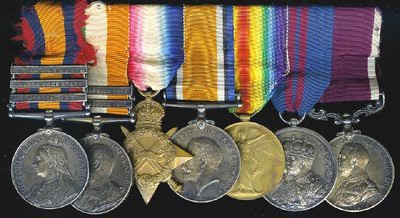
To read the blog, see: British Army Medals (britisharmymedals.blogspot.com/)
MORE ON CUTTING UP NUMISMATIC LITERATURE
Dave Hirt writes:Here is another story of cutting up numismatic literature. This one could well be called a tragedy. I first started collecting coins in the late 1940's when on my paper route, people would sometimes pay me with Barber coins and Liberty Head nickels. My first numismatic book, purchased a few years later, was the Red Book, 5th edition.
About 1953 or 54 in my high school English class, I had to write a paper. I decided to write on coin collecting. By that time I had purchased a 6th edition Red Book, so I cut plates from my 5th edition to illustrate my paper. At the time the cut up edition was only one that had been replaced with an updated one.
Years later when I started collecting numismatic literature, I realized what a terrible thing I had done. I had picked just about the scarcest Red Book. After all these years I still have that mutilated book.
Bob Knepper writes:
I offered some of the catalogs of ancients to the head of the ancient history department at the local university and he was not interested, either for his department or for the school library.
A few years ago I visited the local coin clubs and they were polite but not much interested in non-US coins.
A friend-curator of a European museum collection said he would like to have them but the postage is prohibitive and the weight would exceed our baggage allowance on our intermittent trips.
Considered auctioning them, eBay or other, but again the postage is apparently more than people are willing to pay.
My solution, so far, is to keep certain auction series that cover my old German specialty with a computer index of where to look, plus cutting and filing pictures of coins not pictured in my reference books. One advantage is that I learn about the many variations which aren't shown, often not even mentioned, in the reference books. Also I sometimes see the same coin (same flaw or ?) in multiple auctions.
Any other/better solutions?
Bob's point about the lack of a universal lot index is right on the money. I'm sure that a handful of top catalogers do compile their own indexes to better material in recent sales, but these are their trade secrets, not to be shared with others. It would be a worthwhile project for a numismatic institution library to take on, but where would the funding come from? It would be a huge (but hugely valuable) undertaking. -Editor
NOTES ON COIN DENOMINATIONS
Last week, Bruce W. Smith wrote:David Gladfelter writes:
MORE ON DIGITIZING NUMISMATIC LITERATURE
George Fitzgerald writes:They are putting many books on line, the most books are from our Genealogy Library. They are also scanning books from other libraries. I am a Volunteer at the Library in Genealogy.
As mentioned in a previous newsletter, the Lincoln Museum in Fort Wayne, closed last year and it was decided to give all of the documents to the Allen County Public Library (the artifacts are going the State Museum in Indianapolis). One of the reasons our Library got he collection is that they are going to scan the collection and put it on line. Another paper money collector, Bill Haines, has volunteered to scan some of the Collection. Bill is also a subscriber The E-Sylum.
I know I would like to put some numismatic items on this web site as I have many of thousands of books, catalogs and other items on coins and paper money.
Ben Keele writes:
The Internet Archive (www.archive.org) also has a digitization program and, from what I've heard, tends to have higher, more consistent results. However the ANS or ANA go, they should be careful to ensure that strict quality controls are used.
A random spot-check of other Google-scanned books has yielded some better results, but the general drift is clear: good enough for our mutilated view of the past, rushed through the scanning process so that Google could lay claim to as many artifacts of our cultural past in as short a time and with as small a budget as possible.
To read the complete article, see: Google Books Mutilates the Printed Past (www.resourceshelf.com/2009/06/16/google-books
-mutilates-the-printed-past/)
SCRIBD: AN ALTERNATIVE TO THE AMAZON KINDLE
Arthur Shippee writes:Simon & Schuster, a division of CBS, plans to announce Friday that it will make digital editions of about 5,000 titles available for purchase on the site, including books from best-selling authors like Stephen King, Dan Brown and Mary Higgins Clark. It will also add thousands of other titles to Scribd’s search engine, allowing readers to sample 10 percent of the content of the books on the site and providing links to buy the print editions.
“We are interested in getting our books in front of consumers in as many formats and distribution platforms as possible,” said Ellie Hirschhorn, chief digital officer of Simon & Schuster.
Unlike Amazon, which sets the retail price for its e-books and sells them in its own proprietary Kindle format, Scribd is offering publishers considerably more control over how their digital titles are sold.
Simon & Schuster will sell its books on Scribd for 20 percent off the list price of the most recent print edition. Amazon sets a price of $9.99 for many popular e-books, meaning titles there might be less expensive. But Scribd will allow publishers to see what is selling and change their prices accordingly.
Scribd, a start-up based in San Francisco, also says it is working on a reading application for the iPhone, which should be ready in a few weeks.
The Scribd Web site is the most popular of several document-sharing sites that take a YouTube-like approach to text, letting people upload sample chapters of books, research reports, homework and recipes. About 60 million users a month read documents on the site, embed them in blogs and share links to texts over social networks and e-mail messages.
To read the complete article, see: Simon & Schuster to Sell Digital Books on Scribd.com (www.nytimes.com/2009/06/12/technology/internet/12books.html)
VOCABULARY WORD: REFUTE
Regarding the Colorado Springs Gazette article about the District Attorney's investigation of the former executive director of the American Numismatic Association, George Kolbe writes:"Cipoletti refuted the claims Friday."
Arthur Shippee writes:
I was all set to agree that the reporter should have chosen the words more carefully, thinking that Cipoletti merely denied the charges. To refute them would be to disprove them, and that's for the court to decide.
However, as an Editor I felt compelled to check the dictionary, and found the following definitions in Merriam-Webster. -Editor
2 : to deny the truth or accuracy of refuted the allegations
www.merriam-webster.com/dictionary/refute
To read the earlier E-Sylum article, see: FORMER ANA EXECUTIVE INVESTIGATED; ELECTION BALLOTS DUE JUNE 26 (www.coinbooks.org/esylum_v12n24a13.html)
THE BOOK BAZARRE
1786 CONNECTICUT COPPER FOUND IN NORTH CAROLINA
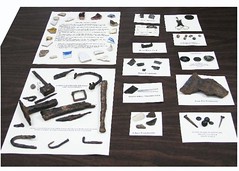 It all started with a coin.
It all started with a coin. When Town of Edenton employee Bobby Williams noticed a coin on the ground where an old home had once stood, he picked it up.
“I was amazed at how good a condition it was in,” he said.
Finding out that it was a 1786 Connecticut Copper coin, and wondering how it got to Edenton, made him want to learn more about the site on Macedonia Road.
As time went on, he picked up other things around the site where a home that had belonged to Penelope Barker had once stood.
There were bits of pottery, buttons, nails and even the remains of what appeared to be a pocketknife.
Following a recommendation from the University of Notre Dame, which had identified the coin for him, Williams shared boxes of items he had found with East Carolina University in Greenville.
Two weeks ago, in response to Williams’ gesture, Dr. Charles Ewen and a team of grad students from ECU visited the site where Williams had turned up his 18th century artifacts.
The home that once stood at the Macedonia Road site has been known by at least two names over the years — the Blenheim Manor House, and the Pagett Plantation.
According to a history of the site compiled by Bobby Williams, the original owner was Dr. Samuel Pagett who received what was possibly already known as Blenheim Manor House with 2,000 in Proprietary Land Grants between 1714-1722.
To read the complete article, see: History beneath the dirt (www.dailyadvance.com/features/history-beneath-the-dirt-667072.html)
INTERVIEW WITH ART OF COUNTERFEITING AUTHOR
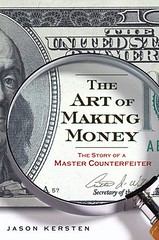 But the U.S. Treasury Department was no match for Art Williams, one of the most inventive and prolific counterfeiters of recent decades. After learning the craft at 16 from his mother's boyfriend, Williams, the product of a tough neighborhood on Chicago's South Side, went on to print an estimated $10 million in fake money by outmaneuvering the government's ever-tightening security measures. Color-changing ink was replicated by automotive paint; watermarks were painstakingly sketched by hand; a close copy of the secret paper came from leftover newsprint rolls made at local mills. Williams had a successful 10-year run before he was finally caught by the U.S. Secret Service and sentenced in 2002 to three years in prison.
But the U.S. Treasury Department was no match for Art Williams, one of the most inventive and prolific counterfeiters of recent decades. After learning the craft at 16 from his mother's boyfriend, Williams, the product of a tough neighborhood on Chicago's South Side, went on to print an estimated $10 million in fake money by outmaneuvering the government's ever-tightening security measures. Color-changing ink was replicated by automotive paint; watermarks were painstakingly sketched by hand; a close copy of the secret paper came from leftover newsprint rolls made at local mills. Williams had a successful 10-year run before he was finally caught by the U.S. Secret Service and sentenced in 2002 to three years in prison.You say that, unlike other criminals, counterfeiters are craftsmen. Is there a part of you that admires the work that they do?
Well, sure. I've seen one of Art's bills. It's just astonishing how similar it is to the genuine article. I tend to be fascinated by any master criminal, anyone who's such a diabolical genius that they take a crime beyond the financial gain.
One striking detail of the story is how Art and his wife would travel around the country and unload their fake bills by buying random supplies and souvenirs, getting real money in change. Then they donated those supplies to charity.
They'd have all this extra stuff, and they'd drop it off at Salvation Armies and churches. That became as important to them as the money itself, that feeling of charity. He wasn't a greedy counterfeiter.
Why do you think he agreed to talk to you? Was part of him proud, and wanted to boast?
Absolutely. You can see in the earlier part of the book that he's a good kid, and he's a smart kid. He skips two grades, he's a straight-A student. That all gets subverted once he goes into the projects in Chicago. I think that 12-year-old kid is still in there wanting to come out, and I think it did with his counterfeit bills.
What was it like to spend time together?
Our core interviews for the book took place over 10 days in a basement apartment on the South Side of Chicago. I was just pulling these stories from his childhood out of him. It was a very emotional process - he would break down crying, telling me about his mother going crazy and his dad abandoning him. That's when the book sort of took a different direction. Yes, it's a book about counterfeiting, but then I started seeing it as the story of a man and his life, and how those things were interwoven.
To read the complete article, see: Q&A: The Art of Counterfeiting Money (news.yahoo.com/s/time/20090615/us_time/08599190459500)
To read the earlier E-Sylum article, see: NEW BOOK: THE ART OF MAKING MONEY: THE STORY OF A MASTER COUNTERFEITER (www.coinbooks.org/esylum_v12n23a04.html)
The reader also included a link to this short, but informative article on how to detect a counterfeit U.S. note. Nothing most numismatists don't already know, but a good fresher.
How to Spot Counterfeit Money (www.divinecaroline.com/22287/73997-spot-counterfeit-money)
QUIZ ANSWER: JAMES D. FOSKETT, FIRST ANS LIBRARIAN
In response to last week's quiz question, Pete Smith writes:That's correct! Foskett served from 1858 to 1864. But can anyone tell us anything about him? The ANS centennial history says little about him. He was one of the signers of the invitation to the first meeting of the organization. The ANS web site has a page devoted to the one-page letter dated March 8, 1858.
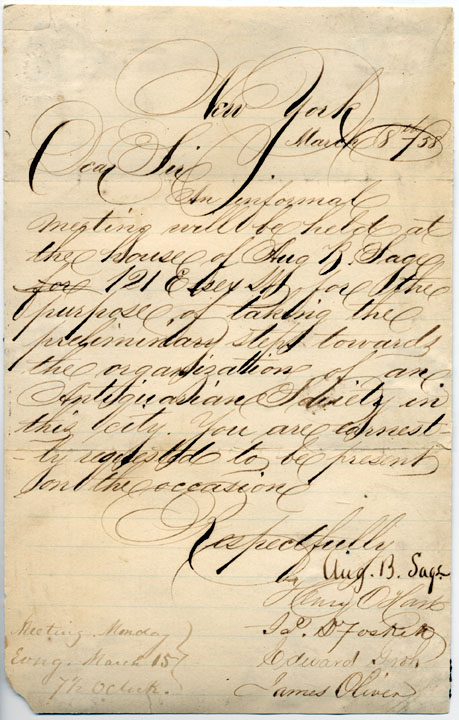
New York
March 8, 1858
Dear Sir,
An informal meeting will be held at the house of Aug. B. Sage, at 121 Essex St. for the purpose of taking the preliminary steps toward the organization of an Antiquarian Society in this city. You are earnestly requested to be present on the occasion.
Respectfully,
Aug. B. Sage
Henry O. Hart
James D. Foskett
Edward Groh
James Oliver
Meeting Monday
evening, March 15
7 o'clock
To view the original web page, see: Invitation to the first meeting of the American Numismatic Society (www.numismatics.org/About/SageLetter)
QUERY: WERE STEUBEN SOCIETY MEDALS DESIGNED BY ALPHONSE KOLB?
The Steuben Society archives contain medals with Steuben likenesses that were customarily given as part of scholastic awards for proficiency in the study of American history or German language. I suspect but cannot be sure that these are from the hand of Kolb. Does anyone out there know this for a fact? Thank you for any information regarding this topic. My email address is steubensociety@aol.com.
To read the earlier E-Sylum article, see: MORE ON SCULPTOR ALPHONSE ANTON KOLB (www.coinbooks.org/esylum_v11n45a08.html)
The Steuben Society of America was founded in May of 1919, in the aftermath of the First World War, by patriotic Americans of German descent. Our mission from the inception of our organization to the present day has remained essentially unchanged. Our goals are to foster good citizenship in the German-American community, to educate the public as to the positive role our ethnic group has always played in American society, and to preserve a sense of ethnic pride amongst German-Americans.
By no means was it an accident that our founders chose to name our organization after one of the greatest German-Americans. Baron Friedrich Wilhelm von Steuben epitomizes all the virtues our society holds most dear. The baron dedicated his life to public service. Von Steuben was recruited to the cause of American Liberty by Benjamin Franklin who persuaded the baron to offer his services, without compensation, to the Continental Congress. The baron, a Prussian officer by training, was given the rank of Major General in the Continental Army and distinguished himself as our country’s first effective Inspector General. He trained the troops through the brutal winter at Valley Forge where he converted a loosely assembled hodgepodge of untrained militia into a fighting force capable of standing toe to toe with the mighty British Army.
For more information on the Steuben Society of America, see: www.steubensociety.org
FIRST NEW YORK NUMISMATIC CLUB MEETING PHOTO
Last week in my review of the latest issue of ANS Magazine I published a photo taken at the first meeting of the New York Numismatic Club. Jerry Fochtman writes:I asked John Kleeberg, who writes:
The photograph reproduced in the ANS Magazine is a photograph of the Club meeting of November 12, 1909 (not the inaugural meeting - the inaugural meeting of the Club was December 11, 1908). This photograph also appears in Mehl's Numismatic Monthly, December 1909, page 194, and in The Elder Magazine, January 1910, page 14. The same photograph also appears in Adelson's 1958 history of the ANS (facing page 157), with many of the persons identified, although with an incorrect date and with many faces retouched. The reproduction in the ANS Magazine is the best one I've seen so far.
The photographs of the November 12, 1909 meeting and of the January 24, 1913 dinner also appear in the New York Numismatic Club History of 1961 (pages 6 and 19) and the 1992 edition of the New York Numismatic Club history (pages 8 and 21), which was largely a reprint of the 1961 edition.
The date of the photograph can be determined from the dates given in Mehl's and Elder's magazines; and also from the fact that John H. Clapp appears, since he did not attend many meetings (he lived in Washington, DC).
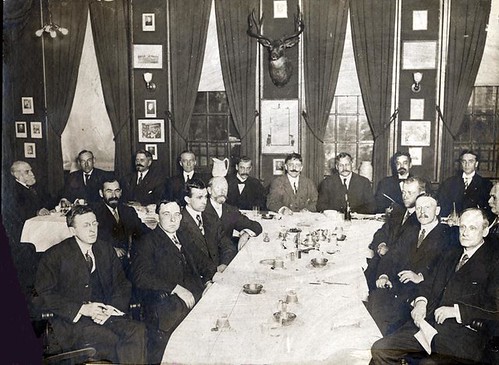
The individuals depicted in the photograph are: Head table, left to right: Bearded man at extreme left, unfortunately unidentified, possibly Charles Leopold Podhaiski or J. A. Clarke; Joseph C. Mitchelson, Elliott Smith (goatee), Daniel R. Kennedy, Albert R. Frey (mustache), Frank C. Higgins (mustache), Edgar H. Adams (mustache), D. Macon Webster (goatee), Thomas L. Elder.
Seated at the left of the front table, left to right: Wayte Raymond (glasses and cigar), Victor D. Brenner (bearded), Elmer Sears, Stephen K. Nagy, Bauman L. Belden (bearded, appears to have a water jug on his head)
Seated at the right of the front table, right to left: George H. Blake, William H. Woodin (mustache, holding cigar), John H. Clapp, and on the extreme right, partly cropped off, William R. Weeks.
Everyone who appears in this picture is important - Brenner, of course, and William H. Woodin, who worked himself to death in 1933-34 saving the U.S. financial system, but it is also the only photograph I know of that shows Stephen K. Nagy (the son-in-law of John Haseltine) whom David Tripp describes in his book on the 1933 double eagle as "the top crook of them all" (Tripp, page 101).
John H. Clapp was one of the prior owners of the Clapp collection, the nearly complete collection of U.S. coins that Louis Eliasberg bought. D. Macon Webster, the attorney of the Club, was a pioneering African-American civil rights attorney. William R. Weeks, another attorney, had a rather uneven career: he served as historiographer and librarian of the ANS, but he also looted his clients' monies and got thrown into Ludlow Street Jail.
While we're correcting things, the Chicago Coin Club was founded in 1919, not 1933, the Brooklyn Coin Club in 1932, not 1933, and the Bronx Coin Club in 1933, not 1934.
The ANS Magazine also has a photo of the 1910 ANA Convention (although the person that is identified as Zerbe I think is actually John Henderson). That's noteworthy because there is no official photograph of the 1910 convention - Mr. "Charles F. Allen," who took the official photograph, collected money from everyone for it and then disappeared.
The photograph in the ANS Magazine (which also appears in Adelson, facing page 160) is probably a snapshot made by Edgar H. Adams, an enthusiastic photographer who also did the plates for Elder's coin auctions.
BASEBALL CURRENCY ADVERTISING NOTES
These are scarce items, probably no more scarce than a typical advertising note of the day. But because of the subject area they are always in demand and sell for over $1,000 today. I recall seeing an exhibit of these at an ANA convention several years ago. -Editor
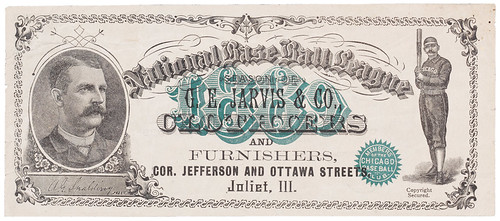
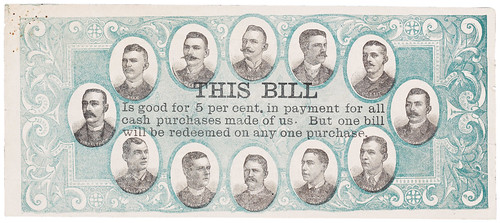
To view the lot description, see: Lot #153: 1889 Baseball Currency featuring Cap Anson and Cubs (Joliet, IL) (www.collect-auctions.com/LotDetail.aspx?lotid=167)
MORGAN, BUFFETT AND THE PANIC OF 1907
As the shortage of circulating money began, some economists felt the gold standard was partially to blame, which resulted in the order for the Denver mint to begin striking $80,000 in silver dollars a day. Many banks agreed, on their own initiative, to pay out no more than $100 a week per account to ward off possible bank runs.
A clearing house cartel was formed to aid one of New York City’s biggest banks, but other banks began to totter, prompting J. Pierpont Morgan to bail out the Trust Company of America, the most solid of the firms in question. All this did was to bring all the other banks’ health into question.

Closer to home, the Lincoln Clearing House was formed by local bankers at the Columbia National Bank, then on the northeast corner of 12th and O streets. From this meeting came preprinted notes on the First National Bank in $1, $2, $5, $10 and $20 denominations to ease the apparent lack of circulating currency available in the city. Five dollar notes on the First National Bank of Bradshaw carried the imprint that they “will be accepted by any bank in York County.” The First Farmers State Bank of Amherst “issued scrip and continued operation as usual,” while the Commercial Bank of Wausa quietly printed and distributed $5 and $10 “notes.”
Nebraska banks issued these notes from October through November, and some had public burning ceremonies when they were redeemed.
Scrip was used by hundreds of banks in 41 states. It also was used by businesses for payrolls, retail firms and even cities, almost always in preprinted standard denominations so they could be recirculated for a stated period of time or until the panic subsided.
Because the federal government stepped in to aid the largest banks, it is tempting to compare the 1907 panic to the current economic recession. Some are also quick to point out the similarities between J.P. Morgan and Warren Buffett, whose Berkshire Hathaway is one of the largest investors in Wells Fargo Bank and the infusion of a reported $8 billion in Goldman Sachs and General Electric. One major difference, however, is that the current downturn will obviously not end in a mere two months.
To read the complete article, see: Jim McKee: Morgan, Buffett and The Panic of 1907 (http://journalstar.com/articles/2009/06/20/news/
nebraska/doc4a3a9232b3e4f634728182.txt)
SAMUEL JOHNSON REMEMBERED WITH COIN COLLECTION GAME
An E-Sylum reader writes: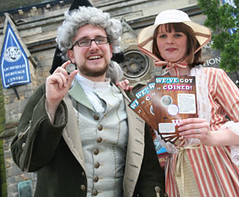 A historic coin competition has been launched in Lichfield to celebrate Samuel Johnson’s birthday.
A historic coin competition has been launched in Lichfield to celebrate Samuel Johnson’s birthday.The council owns a wonderful collection of historic coins and medals. The star of the collection is a Half Crown dating back to Johnson’s time, which is on display in the Lichfield Heritage Centre. A great selection of the coins is also on display in the bookshop at the The Samuel Johnson Birthplace Museum. Joanne Wilson, Museums and Heritage Officer at The Samuel Johnson Birthplace Museum, said:
“We want to know what you think Dr Johnson might have spent the coin on. It could be anything from a quill and ink to a new wig! So if you are aged from four to fourteen, put your thinking caps on and come up with Dr Johnson’s shopping list and you could win a golden ticket to all of the Summer Fun at Sam’s House arts and crafts workshops. The sessions, at The Samuel Johnson Birthplace Museum, will be great fun and are running every Wednesday from July 29 to August 26.”
To read the complete article, see: Lichfield historic coin competition to celebrate Samuel Johnson’s birthday (http://thelichfieldblog.co.uk/2009/06/18/
lichfield-historic-coin-competition-to-celebrate-samuel-johnsons-birthday/)
PUB COINS INSCRIBED BY WWII SOLDIERS
 The Peacock pub in Huthwaite boasts an unusual feature which over the years has become a talking point for visitors. For when landlady Jo Edwards took over the Main Street pub in September last year, she was intrigued to discover around 38 coins nailed to the mantelpiece and the story surrounding them.
The Peacock pub in Huthwaite boasts an unusual feature which over the years has become a talking point for visitors. For when landlady Jo Edwards took over the Main Street pub in September last year, she was intrigued to discover around 38 coins nailed to the mantelpiece and the story surrounding them.Said Jo: "I only know a bit about them, but various people have come in and mentioned them so I asked around.
"Apparently, they were put there by soldiers from Huthwaite during the Second World War.
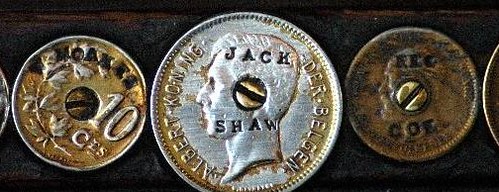
"They had come in for some final drinks and before they went off again, they engraved their names on the coins and nailed them to the mantelpiece."
Added Jo: "People often come in and mention them — one lady came in last week and said that her uncle is on there. It is a very interesting thing for the village."
To read the complete article, see: Pub coins honour Huthwaite heroes (www.chad.co.uk/ashfieldnews/Pub-coins-
honour-Huthwaite-heroes.5369340.jp)
FLEA MARKET BOOK PURCHASE INCLUDED A NATIONAL BANK NOTE
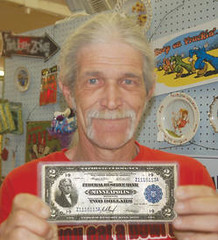 Bob Coggins, who does handyman work and other odd jobs for Green Forest Police Chief John Bailey, was browsing through the used books at Macdoo's flea market on Green Forest's Main Street in early May when he saw an old book that caught his interest. He bought it, but put it aside.
Bob Coggins, who does handyman work and other odd jobs for Green Forest Police Chief John Bailey, was browsing through the used books at Macdoo's flea market on Green Forest's Main Street in early May when he saw an old book that caught his interest. He bought it, but put it aside. Last week, he sat back in his easy chair, opened the book and a piece of paper fell out.
It was an over-sized $2 bill with a battleship on the back. Bob looked it over, noticed that it had two different dates--1914 and 1918--and thought maybe he had something.
Kerby kept researching on the Internet and found that in the last month, bills similar to the one held by Coggins had sold for $1,500 and more at a couple of Internet coin shops. Furthermore, a pristine, uncirculated bill identical to Coggins' was currently being offered for $4,750 by a dealer in California.
In collectors' language, the bill is known as a "1918 $2 Battleship FRBN Minneapolis."
It is the only large-sized, $2 bill issued as a Federal Reserve Bank Note. Each note has the issuing Federal Reserve Bank's name, such as Denver or San Francisco or New York, and could only be redeemed at that bank. The front of the note features a portrait of Thomas Jefferson to the left and wording in the entire center. The reverse features a World War I battleship, the only U.S. currency ever to do so.
It would look nice in a frame on the wall of Coggins' apartment, he admits, but he'd rather have the cash.
To read the complete article, see: Surprise windfall found in pages of used book (www.carrollconews.com/story/1547828.html)
ANOTHER GREAT FLEA MARKET FIND: THE FEDERALIST PAPERS
Indiana National Guard Capt. Nathan Harlan was 16 when he paid $7 for the 1788 book that's the first part of a two-volume book of essays calling for the ratification of the U.S. Constitution.
Nineteen years later, his purchase at a South Bend flea market netted the divorced father of three a more than 11,000-fold return.
Harlan, 35, of Granger, said he finished his training at Camp Atterbury on Tuesday in time to log onto Heritage Auction Galleries' Web site and watch final bidding on the book that until recently he had kept in a shadowbox.
"I was yelling as the bids were coming in — it was like watching the Super Bowl for me," Harlan said. "The outcome was way beyond my expectations."
Harlan will leave this summer for up to a year in Iraq with the 38th Combat Aviation Brigade. He said he likely won't receive the money from the auction until he is on his way overseas.
The two-volume set of "The Federalist" — also known as "The Federalist Papers" — was published months after the Constitution was drafted in September 1787 in Philadelphia.
Its collected essays helped rally support for ratifying the document that provided the federal government's framework, said Mark Dimunation, chief of the rare book and special collections division at The Library of Congress.
The essays were penned by James Madison, Alexander Hamilton and John Jay, all of whom used the same pseudonym to focus attention on their pro-ratification arguments.
"It turned out in retrospect to be a very important summation of the political thought of that period, and one of the great political documents that's come out of America," Dimunation said.
To read the complete article, see: Indiana soldier's rare `Federalist' copy nets $80K (http://www.comcast.net/articles/news-national/
20090615/US.Soldier.Book.Auction/)
STOLEN ICE HOUSE COVER STAMP RESURFACES
 An envelope from an 1873 letter bearing a scarce 90-cent stamp with Abraham Lincoln fetched more than $431,000 at an auction in New York City on Saturday.
An envelope from an 1873 letter bearing a scarce 90-cent stamp with Abraham Lincoln fetched more than $431,000 at an auction in New York City on Saturday.The envelope, or cover, as collectors call used envelopes, was sold by Siegel Auction Galleries.
Known to collectors as the Ice House Cover, the envelope, which traveled by ship from New York to India, is the only one collectors have found still bearing the red and black stamp with Lincoln on it. Last traded publicly in 1943, then stolen and long thought to have been lost to philately, the cover was seized by the Federal Bureau of Investigation in 2006 and returned, after a court battle, to the heirs of J. David Baker, its last owner.
The letter was sent from a New England ice merchant to one of his ice warehouses in Calcutta, then part of Britain’s East Indies colony. It was franked with a total of $1.12, a large sum of money in those days, which paid the two-ounce foreign letter rate.
Markings on the envelope reveal that it traveled across the Atlantic, by train through Germany and Italy, by ship to Egypt and again from Suez to Bombay, and then by train across India. Before the advent of the Universal Postal Union the next year, the sum reflected rates negotiated between the United States and Britain to encourage growing international trade. Indeed, the commercial success of sending ice from winter ponds in Massachusetts to the sweltering cities of India was part of this progress.
In 1914, a New York collector traveling in India did come across one. He sold it to a dealer in New York for $50 or $100 — accounts vary — and by the 1960s it had been sold to Mr. Baker, a steel executive and prominent collector in Indianapolis, for $6,500.
One night in 1967, a prized group of about 250 rare covers, including the Ice House Cover, was stolen from his home. The F.B.I. found most of those covers a decade later, and Mr. Baker was able to buy them back from his insurance company. But the Ice House Cover was missing.
In early 2006, however, an elderly couple walked into a stamp shop in Chicago to ask about the value of some old envelopes they had found while cleaning the home of a deceased friend. The store owner recognized the Ice House Cover and alerted the police. After an investigation by the F.B.I. cleared the couple, the cover was returned by court order to Mr. Baker’s widow and daughter. In May, the Philatelic Foundation, a nonprofit organization in New York, examined the cover and declared it genuine.
To read the complete article, see: $431,000 Paid for Envelope and Its Stamp (http://www.nytimes.com/2009/06/15/us/15stamp.html)
GERMAN VENDING MACHINES TO DISPENSE GOLD
 Shoppers in Germany will soon be able to buy gold as easily as bars of chocolate after a firm announced plans to install vending machines selling the precious metal across the country.
Shoppers in Germany will soon be able to buy gold as easily as bars of chocolate after a firm announced plans to install vending machines selling the precious metal across the country.TG-Gold-Super-Markt aims to introduce the machines at 500 locations including train stations and airports in Germany.
The company, based near Stuttgart, hopes to tap into the increasing interest in buying gold following disillusionment in other investments due to the economic downturn.
Gold prices from the machines – about 30 per cent higher than market prices for the cheapest product – will be updated every few minutes.
Customers using a prototype "Gold to go" machine at Frankfurt Airport on Tuesday had the choice of purchasing a 1g wafer of gold for €30, a 10g bar for €245, or gold coins.
A camera on the machine monitors transactions for money laundering controls.
Jens Willenbockel, an investment banker who saw the machine while passing through the airport, told the Financial Times that he believed there could be a market for the venture.
"Because of the crisis there is a lot of awareness of gold," he said. "It is also a great gift for children – for them getting gold is like a fairytale."
To read the complete article, see: Gold Sold Like Chocolate from German Vending Machines (www.telegraph.co.uk/finance/financetopics/financialcrisis
/5554972/Gold-sold-like-chocolate-from-German-vending-machines.html)
LARGEST COUNTERFEIT CRIME IN HISTORY?
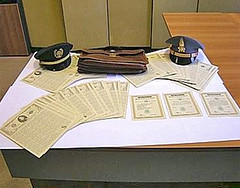 Italy's financial police, Guardia Italiana di Finanza, have arrested two Japanese citizens as they attempted to smuggle $134 billion worth of U.S. bonds in the false bottom of a suitcase by train into Switzerland, Jerome Corsi's Red Alert reports.
Italy's financial police, Guardia Italiana di Finanza, have arrested two Japanese citizens as they attempted to smuggle $134 billion worth of U.S. bonds in the false bottom of a suitcase by train into Switzerland, Jerome Corsi's Red Alert reports. The bonds appeared to include 249 certificates U.S. Federal Reserve bonds worth $500 million each plus various other U.S. government securities worth a billion dollars each, including what are known as "Kennedy Bonds" bearing a portrait of President John Kennedy on the front and a shuttle launch on the reverse.
"Italian authorities have not yet determined whether the bonds are real or fake," Asia News reported in breaking the story, "but if they are real the attempt to take them into Switzerland would be the largest financial smuggling operation in history."
"If they are fake," Asia News continued, "the matter would be even more mind-boggling because the quality of the counterfeit work is such that the fake bonds are undistinguishable from the real ones."
The Guardia di Finanzia indicated Italian authorities were working to determine whether the bonds and the documentation accompanying them were authentic.
No determination had yet been made whether the bonds were counterfeit, nor was any other information released about the identity or background of the two Japanese men apprehended in the incident.
To read the complete article, see: Smuggled: $134 billion in U.S. bonds (www.wnd.com/index.php?fa=PAGE.view&pageId=101134)
Few details have been revealed beyond a June 4 statement by the Italian finance police announcing the seizure of 249 US Treasury bills, each of $500m, and 10 "Kennedy" bonds, used as inter-government payments, of $1bn each. The men were apparently being tailed by the Italian authorities.
Yesterday the mystery deepened as an Italian blog quoted Colonel Rodolfo Mecarelli of the Como provincial finance police as saying the two men had been released. The colonel and police headquarters in Rome both declined to respond to questions from the Financial Times.
"They are all fraudulent, it's obvious. We don't even have paper securities outstanding for that value,'' said Mckayla Braden, senior adviser for public affairs at the Bureau of Public Debt at the US Treasury department. "This type of scam has been going on for years.''
The Treasury has not issued physical Treasury bonds since the 1980s - they are handled electronically - though it still issues savings bonds in paper format.
To read the complete article, see: Trail of fake Treasury bills leads to Mafia (www.ft.com/cms/s/0/4d6e4418-5c6a-11de-aea3-00144feabdc0.html)
FUN WITH 250 LIBRARIANS
"Great," said her mother. "How much is that in American money?"
FEATURED WEB PAGE: MARK WAGNER’S CURRENCY COLLAGES
This week's Featured Web Page is recommended by Ron Guth. Instead up cutting up literature, Mark Wagner’s Currency Collages are made of cut-up U.S. currency. These artworks are very imaginative and cleverly done. Check them out!
www.bextim.com/mark-wagners-currency-collages.html
